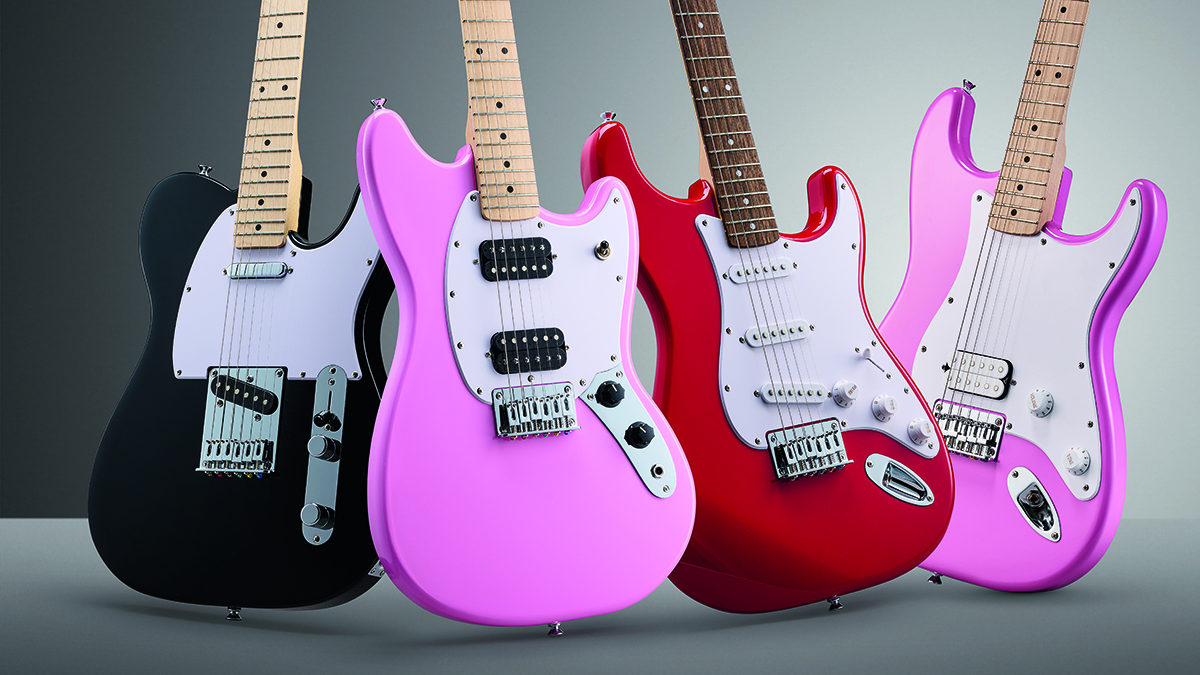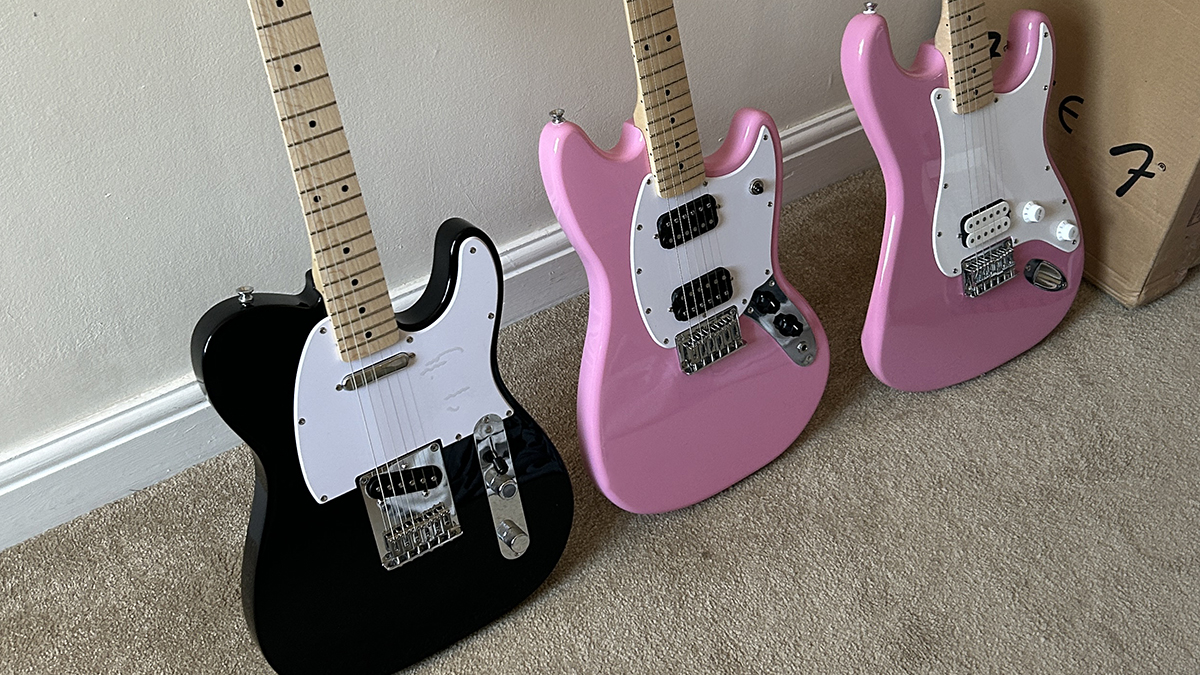
It’s fair to say I’ve had my finger on the pulse of practically every single new guitar release this year. My job means I’ve read and researched all about the latest high-end instruments, from Martin’s $18k John Mayer acoustic guitar to Gibson’s $50k Greeny signature guitar.
But, like many guitar fans, the releases that particularly piqued my interests in 2023 – especially given the current financial climate we find ourselves in – were those that had affordability in mind.
And, when it comes to affordability, there is one drop that perhaps sticks out as the best of the bunch: the Squier Sonic range.
Drafted in to replace the now-retired Bullet range – which famously found favor with Genesis’ Mike Rutherford – the Sonics were Squier’s new-and-improved arsenal of cheap electric guitars and bass guitars, with prices starting from just $199.
Yes, you had your usual Stratocasters and Telecasters, but the Sonic series also introduced new Mustangs, a humbucker-loaded Esquire and, perhaps most intriguingly of all, a single pickup Strat of a similar ilk to Tom DeLonge’s recently revived signature model.
Having had experience playing Bullet Strats and Teles, I was aware of the potential they offered for their minuscule price tags. But price and components aside, the guitars themselves were very handsome indeed.
From the vintage-flavored 2-Color Sunburst Stratocaster to the contemporary Flash Pink Mustang and Ultra-Violent Esquire, the range catered to all aesthetics, offering a suite of knockout colorways and classic Fender body shapes – all at an accessible price point. I was besotted.
Get The Pick Newsletter
All the latest guitar news, interviews, lessons, reviews, deals and more, direct to your inbox!
As such, I found myself eyeing up one of the Mustangs: the SS-configured sunburst model, to be precise.
However, before I could pull the trigger, I was given some timely news: I’d been given the chance to review four models from the Sonic range for the latest issue of Total Guitar. Jackpot.
While the sunburst Mustang wasn’t part of that review collection, I did manage to get my hands on the HH version, as well as a Telecaster, hardtail Stratocaster, and the eye-popping pink-finished single-humbucker Strat.

I was given a generous three-week period to put these guitars through the ringer before submitting the review, and I was fully expecting to devote most of that time playing the models that gave me greater switching options. Oh, how wrong I was.
Now, let me preface what I’m about to say by admitting that I have never understood the single-pickup hype. For my entire guitar-playing journey, I’ve been a strong advocate for two-plus pups (my usual guitars are an HH Thinline Tele and SSS Strat), and I have simply never understood the appeal behind limiting oneself sonically to just one humbucker.
Of course, far better players than I have been able to create masterpieces – and indeed shape the trajectory of guitar music itself – with a one-pickup guitar, but for me (as a fan of neo-soul, blues and indie rock) it’s never been something I’ve been keen to try.
That’s why I was mighty perplexed to find out it was in fact the Stratocaster HT H that became my standout favorite of the four. It wasn’t even a competition: this pink beauty was the clear winner.

Why, when I had spent over a decade playing exclusively SSS and HH configurations, did I find myself coming back to a guitar I’d previously had no interest in? As an ardent standard Strat loyalist, why was I shunning the gorgeous red model I had been given, in favor of a guitar I’d never even consider buying for myself?
At first I thought it was just the sheer novelty of it, but the more I played, the more I realized that wasn’t the case. Before long, I decided I needed to hold my hands up and say, “I was wrong.” I completely get it now.
Sure, the rest of the Sonics were fantastic instruments in their own right and I was blown away by their overall performance (watch out for the forthcoming review for more on those), but I can’t remember having as much fun noodling on a guitar as I did every time I picked up that HT H model.
Stranger still, I usually live in the neck and middle pickup positions, but the bridge humbucker of this beast utterly wooed me. Interestingly, the lack of switching options brought out another, far more dynamic side of my playing, and I found the inability to faff around with pickup options incredibly liberating. I simply had to play the thing, and rely on my hands to squeeze out any nuances I required.

The Sonic range has been touted as the heir to Squier’s modding throne, and by the time my three weeks with the guitars was up, I had already plotted a master plan to pimp out a HT H of my own: a Wide Range humbucker and a better hardtail bridge were among the specs.
Another highlight of this guitar is the fact it has a regular ol’ Strat routing. The benefits of this are two-fold: first, it meant the poplar-bodied guitar itself was uber-resonant, and second, it allows for standard pickup configurations to be installed retrospectively.
A genuinely fun, inspiring and enlightening instrument that offers a world of modding possibilities? All for just $199?! Say no more. Safe to say I was heartbroken when I had to send it back.
All said and done, I am no longer thinking about buying that sunburst Mustang that had initially piqued my interest. Instead, I’m seriously considering a single-pickup Stratocaster – words I never thought I’d hear myself say.

Matt is the GuitarWorld.com News Editor. He has a Masters in the guitar, a degree in history, and has spent the last 16 years playing everything from blues and jazz to indie and pop. When he’s not combining his passion for writing and music during his day job, Matt records for a number of UK-based bands and songwriters as a session musician.
“It combines unique aesthetics with modern playability and impressive tone, creating a Firebird unlike any I’ve had the pleasure of playing before”: Gibson Firebird Platypus review
“This would make for the perfect first guitar for any style of player whether they’re trying to imitate John Mayer or John Petrucci”: Mooer MSC10 Pro review










